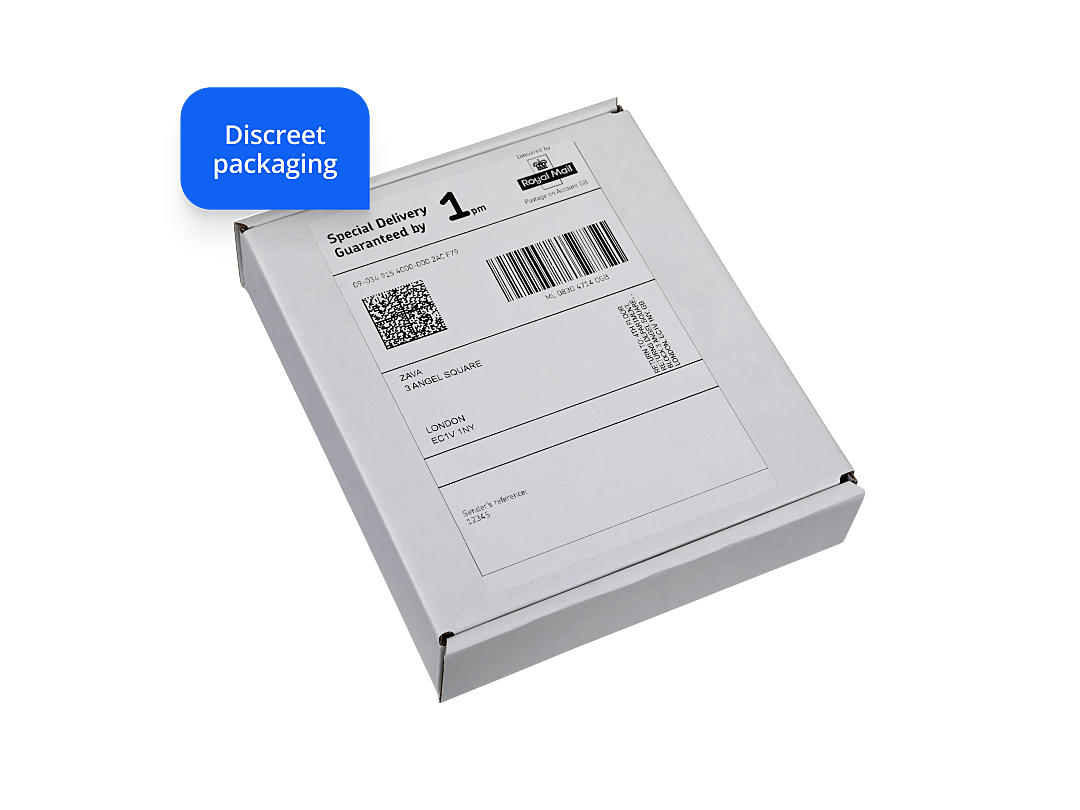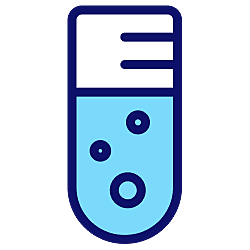Testosterone Test Kit
Check your testosterone levels with our simple testosterone home test kit.
(1)





-
Our testosterone test kit contains everything you need to check your testosterone levels at home. You do not need to visit your doctor to have your blood taken. All you need to do is a quick finger prick blood test.
After you’ve sent the sample off to our lab, you’ll get your results within a few days to your confidential ZAVA account. One of our doctors will explain your results as well as any further advice.
If your test result is slightly low, you may be asked to do a repeat blood test in 4 to 8 weeks to confirm if you have a testosterone deficiency. If this is the case, you’ll need to speak to your doctor or a specialist doctor to start testosterone replacement therapy.



About home testosterone testing
-
-
You can use the home testosterone test kit if you want to check if your testosterone levels are within the normal range. You might do the test if you have symptoms of low or high testosterone.
You can order a test kit from ZAVA if you are a man over 18 years old.
Testosterone is a type of male sex hormone, also known as an androgen. Your body will produce testosterone whether you are a man or a woman, but men tend to have around 10 times more testosterone than women. In women, testosterone is quickly converted into female sex hormones.
In men, testosterone is made in your testes (where your sperm is produced, too). A gland in your brain called the pituitary gland controls the levels of testosterone in your body.
A testosterone deficiency is also known as hypogonadism. Symptoms of low testosterone in your body include:
- low sex drive
- hot flashes
- mood changes like depression or being easily irritable
- erectile dysfunction
- less body hair growth
Testosterone is also needed to keep your bones in good health. If you have low testosterone levels, your bones can become more brittle. This is called osteoporosis. Brittle bones are a sign of low bone density, which means you'll have a higher risk of having a fracture.
If you have high testosterone levels, this can lead to:
- low sperm count
- acne
- fluid retention
- weight gain
- headaches
- insomnia
- mood changes like being more irritable or having an impaired sense of judgement
Too much testosterone in your body can also increase your risk of heart disease as your blood pressure and cholesterol (fat) levels can rise.
-
-
This test will detect the level of free testosterone in your blood. Most of the testosterone hormone in your blood is bound to a protein. This protein will release some testosterone when your body needs it. The blood test will detect the amount of total testosterone.
Your results will be checked by a doctor, and they will suggest whether or not you need treatment. This could involve using a testosterone replacement medicine.
All you need to do is prick your finger to collect a small sample of blood. You can do this at home as the test kit provides everything you need.
-
-
Before you use the testosterone test kit, make sure you do not eat or drink after 11pm the night before until you take your test. You can drink water. If you need to take medications that need food or you are not able to fast, speak to your doctor first.
If you take blood thinning medication (anticoagulants), speak to your doctor before you take this test.
Take your blood sample between 7am and 11am. If you’re feeling unwell, wait till you feel better to take the test. Before you take your test:
- wash and dry your hands
- use the alcohol swab to clean the fingertip that you’d like to take the sample from
It might be best to use the hand that you do not write with (your non dominant hand) in case your finger feels sore afterwards.
Your test kit will come with 3 lancets (finger prickers) and a collection tube. If the lancet does not work the first time, you can use another one to try again. To take your sample:
- twist and remove the purple stick from a lancet
- place the lancet on your clean fingertip and press down on the purple button at the end
- you’ll feel a small prick and should see a small drop of blood on the tip of your finger
- wipe the first drop away with a tissue
- massage your finger until another drop of blood forms
You can also hold your hand downwards to encourage the flow of blood. You will need to:
- catch the drops of blood into the collection tube
- keep squeezing your finger gently to fill up to the upper line of the tube
If no more blood is coming out of your fingertip, try using another lancet on a different finger. You need to fill the collection tube up to the line to make sure there’s enough blood for the laboratory to test.
The bleeding should stop naturally. If it has not, you can use the plaster provided to stop the bleeding.
Once the tube is filled, screw the lid back on securely, and:
- fill out your details on the sticky label provided and affix it to the tube
- place the collection tube inside the protective wallet, and then place the wallet inside the prepaid envelope
Your lancets contain needles that need to be disposed of appropriately. You can put your used lancets inside the envelope. Once posted, the lab will dispose of the lancets for you.
You can use any UK post box to send your test kit to our lab.
-
-
It’s best to use the testosterone test kit first thing in the morning, between 7am and 11am. Testosterone follows a circadian rhythm which means the levels of the hormone will change over 24 hours. Your testosterone levels are higher in the morning, so your test results will be more accurate if you take the sample then.
This is a fasting blood test. You need to make sure you do not eat or drink anything except for water from 11pm the night before you take the test.
Speak to one of our online doctors before you use the test kit if you:
- cannot fast due to a health condition, such as diabetes
- take prescription medications in the morning that might affect your testosterone levels
If you feel unwell, wait until you get better before using the test kit. Your testosterone levels can change when you are unwell so it’s best to wait until you’ve fully recovered.
-
-
Your result will come back as a number describing how much total testosterone you have in nanomoles per litre (nmol/L). This is just a way to display the results. It’s more important to compare your result to the normal range for testosterone in adult men.
The usual total testosterone level for men between 19 to 39 years old is 12 to 31 nmol/L.
Once you get your results back, one of our doctors will let you know if there are any further steps to take. Remember that the test result should be looked at with your symptoms. If you still have symptoms of high or low testosterone but your blood test result is normal, speak to your doctor.
If your testosterone level is low, you may benefit from testosterone replacement therapy (TRT). TRT involves taking testosterone supplements to make up for your body’s hormone deficiency. There are different types of TRT available, including Testogel or Tostran gel, and Nebido injections.
You should always start TRT when advised by your doctor or specialist. You can request TRT from ZAVA if you are currently using TRT under a specialist and:
- are aged between 18 and 65
- are up to date with your blood tests and appointments
- have been on TRT for at least a year
- do not have any health conditions that makes TRT risky to use
-
-
Our testosterone blood test is sent to a UK based accredited laboratory, making the results reliable and accurate. To make the test more accurate, you may need to do it more than once.
Though the test result itself will be accurate, the behaviour of testosterone in your body may change due to several factors. Your doctor might ask you to repeat the test after a few weeks to check if your testosterone levels stay the same or change.
For more accurate results, take the test in the morning. Your body will naturally produce more testosterone during the morning, so it’s best to do your test then before eating any food.
Food, medications and some health conditions can affect your testosterone levels. Make sure you have been fasting since the night before to make sure your results are as accurate as possible.

Dr Babak Ashrafi Clinical Lead for Service Expansion
Accreditations: BSc, MBBS, MRCGP (2008)
Babak studied medicine at King’s College London and graduated in 2003, having also gained a bachelor’s degree in Physiology during his time there. He completed his general practice (GP) training in East London, where he worked for a number of years as a partner at a large inner-city GP practice. He completed the Royal College of GPs membership exam in 2007.
Meet our doctorsLast reviewed: 04 Feb 2022
-
Testosterone for hypogonadism in males (Buckinghamshire CCG) [April 2019] [accessed Jan 2022]
-
What is testosterone? (Healthline) [Jan 2021] [accessed Jan 2022]
-
Testosterone — What It Does And Doesn't Do (Harvard) [Aug 2019] [accessed Jan 2022]








